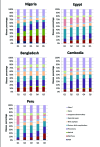Optimizing community case management strategies to achieve equitable reduction of childhood pneumonia mortality: An application of Equitable Impact Sensitive Tool (EQUIST) in five low- and middle-income countries
- PMID: 23289077
- PMCID: PMC3529311
- DOI: 10.7189/jogh.02.020402
Optimizing community case management strategies to achieve equitable reduction of childhood pneumonia mortality: An application of Equitable Impact Sensitive Tool (EQUIST) in five low- and middle-income countries
Abstract
Background: The aim of this study was to populate the Equitable Impact Sensitive Tool (EQUIST) framework with all necessary data and conduct the first implementation of EQUIST in studying cost-effectiveness of community case management of childhood pneumonia in 5 low- and middle-income countries with relation to equity impact.
Methods: Wealth quintile-specific data were gathered or modelled for all contributory determinants of the EQUIST framework, namely: under-five mortality rate, cost of intervention, intervention effectiveness, current coverage of intervention and relative disease distribution. These were then combined statistically to calculate the final outcome of the EQUIST model for community case management of childhood pneumonia: US$ per life saved, in several different approaches to scaling-up.
Results: The current 'mainstream' approach to scaling-up of interventions is never the most cost-effective. Community-case management appears to strongly support an 'equity-promoting' approach to scaling-up, displaying the highest levels of cost-effectiveness in interventions targeted at the poorest quintile of each study country, although absolute cost differences vary by context.
Conclusions: The relationship between cost-effectiveness and equity impact is complex, with many determinants to consider. One important way to increase intervention cost-effectiveness in poorer quintiles is to improve the efficiency and quality of delivery. More data are needed in all areas to increase the accuracy of EQUIST-based estimates.
Figures












References
-
- IGME. Levels and trends in childhood mortality report. New York: IGME, 2011. Available from: http://www.childinfo.org/files/Child_Mortality_Report_2011.pdf Accessed: 6 June 2012.
-
- UNICEF, World Bank. Marginal budgeting for bottlenecks. UNICEF, 2010. Available from: http://www.who.int/pmnch/topics/economics/costingtools_resources/en/inde... Accessed: 15 June 2012.
LinkOut - more resources
Full Text Sources
